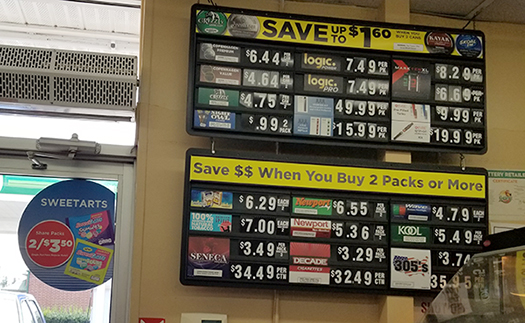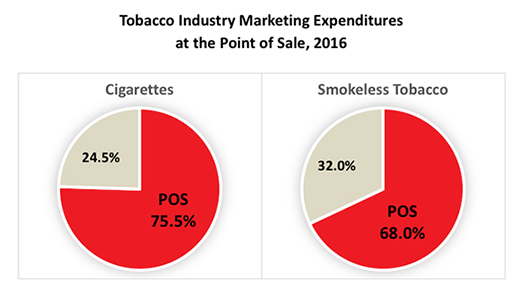News and Events
Point-of-Sale Tobacco Advertising Increases the Risk of Youth Tobacco Use
By Tracy DeCubellis
September 6, 2018
The new school year is just starting for 2018-2019. It is a busy and exciting time as students move up to the next grade level, or start school for the first time. Busses, minivans, and groups of students walking together all converge upon the schools with great energy and excitement about what potential this new school year has in store.
As the busses, minivans, and groups of students make their way to the school, however, they are all passing tobacco advertisements at local retailers. They see advertisements with price promotions, or maybe even new electronic smoking gadgets like e-cigarettes or vapes. So, while they are going to school to learn lifelong lessons that will serve them into adulthood, are they also being influenced on the way to and from school to pick up a habit that will last them into adulthood?
If there is one thing we’ve learned from tobacco company internal memos it is that they have their eyes on our youth as their next group of customers. When Congress gained access to internal tobacco company memos, we found out for sure that added flavors like cherry and honey, colors, and even branding were all geared to attract the attention of kids.

An organization started by the University of North Carolina called Counter Tobacco explains what is happening at gas stations and convenience stores where tobacco is being sold. They explain that tobacco companies are spending $1,000,000 per day in advertising at local retail shops. That means tobacco companies are using ads to build relationships with potential customers. Those potential customers are our kids.
Research shows us that kids are influenced by tobacco advertising. This makes sense. Why would tobacco companies spend $1,000,000 per day on something that has no impact? That would be an enormous waste of money. What the research reveals is that students who attend schools in neighborhoods with a higher density of tobacco retailers have more risk of becoming smokers (Henrickson, et al., 2008). A new study of at-risk youth susceptibility to tobacco advertising further shows that these students had a higher risk of smoking e-cigarettes, cigarettes and cigars. They also had a higher risk of using smokeless tobacco. This study concluded that advertising at the point of sale actually had an influence on the use of alternative tobacco products (like e-cigarettes) among at-risk youth (Beleva, et al., 2018).

E-cigarette use has exploded among Florida youth. Research indicates that advertising influences youth to try products. As Counter Tobacco says, ads build relationships with potential customers. Go to a local convenience store and look around. Are ads for candy or sweet items near tobacco or tobacco advertisements? Are tobacco advertisements waist high or lower on the entry doors? Are any tobacco products or e-cigarettes placed on the counter (even in clear cases), or near things that kids would buy? The chances are very high that you will answer “yes” to one or more of these questions. Whose attention do you think these types of advertisements are meant to attract?
Communities can make some changes to the local retail environment to help keep youth from being influenced by the million dollar per day influence of tobacco companies. Simple changes such as creating ordinances that keep all tobacco behind the counter, not even in closed displays, will take it out of the faces of students buying a soda or candy bar after school. Limiting the number of retailers near schools and parks where kids will be influenced by advertising can also be an important step. Tobacco and nicotine products are for adults only. Creating local licensing for hookah bars and e-cigarette shops can also protect youth from visiting stores that sell adult-only items. Communities can use policies that fit with their schools, neighborhoods, parks and common areas to make sure that kids can just be kids without the tobacco industry constantly attracting them with their million dollars of advertising each day.
___________________________________________________________________
References:
- Beleva, Y., Pike, J.R., Miller, S., Xie, B., Ames, S.L., & Stacey, A.W. (2018). Share of
advertising voice at the point of sale and its influence on at-risk-students’ use of alternative tobacco products. Nicotine & Tobacco Research. doi:10.1093/ntr/nty152 - Counter Tobacco. https://countertobacco.org/about-us/
- Henrickson, L., Feighery, E.C., Schleicher, N.C., Cowling, D.W., Kline, R.S., &
Fortmann, S.P. (2008). Is adolescent smoking related to the density and
proximity of tobacco outlets and retail cigarette advertising near schools? Preventative Medicine, (47), 210-214.




